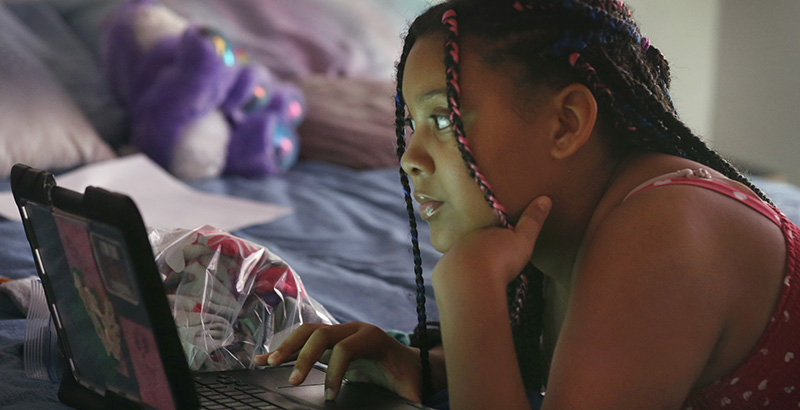What if Washington, D.C. Launched a Free Internet Program For Students But Almost No One Signed Up? 7 Months Later, Initiative’s Reach at 36 Percent of Capacity

A free D.C. Internet program created last fall to connect thousands of low-income students is still only at a fraction of its capacity more than seven months after rollout.
Since September, D.C.’s $3.3-million Internet for All program has “received interest” from about 9,000 households of the 25,000 the program can serve for a year — just 36 percent, according to the Office of the Chief Technology Officer.
OCTO would not say how many of those families are currently receiving the service or are waiting for it to be set up — only that it put those 9,000 families in touch with Comcast or RCN, the providers D.C. is compensating to supply free Internet.
Advocates are pointing to the lag as a key reason to shift from patchwork fixes to sustainable, long-term solutions that establish low-cost, fast and reliable service citywide, so all residents have more equitable opportunities to succeed in school and the workforce.
While families could still benefit in the interim from the Internet for All program, “We haven’t done enough as a city to make it appealing,” D.C. Council member Janeese Lewis George wrote to The 74 in a statement.
George noted how Chicago, which adopted a similar program last year, collaborated with “existing and trusted community based organizations” to spread the word, “and they’ve signed up a lot more people.”
More than a year into the pandemic, unreliable Internet is still a reality for many D.C. families. About 76 percent of teachers in a March D.C. State Board of Education survey said slow student Internet continues to impede learning, while 42 percent said students “having no Internet access” is a barrier.
Yet the free program remains under enrolled.
Early on, officials struggled to convince families the program wasn’t a scam. Many had also already opted to rely on school resources like hotspots, which were available sooner after schools first closed and were less of a lift for non-tech savvy parents who couldn’t “set up the basement WiFi,” said Maya Martin Cadogan, executive director of D.C. parent advocacy group PAVE.
D.C. Council member Brooke Pinto also worries some families fell through the cracks as program outreach largely involves emailing, texting or calling families and requiring them to opt in.
“Not everybody has access to Internet to even know” the program exists, she said. “[We need] more proactive outreach … so families can access this service without having to do their own homework.”
Some parents who did hear about the program and sought to enroll said there was confusion around eligibility requirements, too.
D.C. mom Sharnetta Boone-Ruffin inquired twice last year, believing she was eligible because she has a sixth grader and was receiving SNAP benefits. She said Comcast first told her she was ineligible because of an outstanding bill. Boone-Ruffin paid the bill, she said, only to be told that as a previous Comcast customer, she was still ineligible.
OCTO confirmed that per its agreement with Comcast, these shouldn’t be disqualifying factors.
With her daughter struggling to meaningfully engage in school work with only a hotspot, Boone-Ruffin, who’s a daycare teacher, felt she had no choice but to shell out $269 a month for a robust Comcast package— even if it meant taking up a side job tutoring to foot the bill.
“It was very frustrating,” she said. “How is [this program] helpful if I can’t give my child the free resources she needs to do a successful job in school? To stay on the principal’s honor roll? To keep perfect attendance?”
An OCTO spokeswoman said their team is “continuously working” to reach more families. The program’s funding is usable through September 2022, and “we will continue to allow residents to sign up as long as capacity and funds are available,” she added.
A short-term fix
Even if Internet for All had engaged more families from the onset, Cadogan noted the current program was meant as a band-aid during distance learning. Thinking long-term, she said, residents need Internet solutions that are both sustainable and higher quality.
Initially, “We were just trying to answer the question of, ‘Do people have access?’ And a yes or no question is important,” she said. “But a yes or no question is not where it stops when you’re talking about equity.”
In addition to the program’s fixed funding allotment, the service quality can be spotty, especially for families with multiple kids and devices. The package speeds recently grew from 25 megabits per second to 50 mbps, but still fall well below the national average of 94.6 mbps recorded last year.
Kesara Brewster, a mom of five students, used to pay $9.95 a month for the Internet Essentials package Comcast offers families via Internet for All, and said Comcast automatically transitioned her to the free program. While she appreciates the savings, Brewster said the service speed hasn’t been sufficient during virtual learning; the family often uses hotspots and cell phone WiFi to compensate.
She wishes the program let families choose between free service or continuing to pay $9.95 a month for upgraded broadband speeds. That way, “I wouldn’t be spending more money than I was already spending, but I would be getting better service,” she said.
D.C. Mayor Muriel Bowser did announce earlier this month she expects all D.C. public schools to fully reopen starting in the fall. This shift back to in-person learning doesn’t diminish the importance of improving Internet access, though, sources interviewed said.
“The world is technology based right now,” said Dayana Smith, a junior at Eastern High School. “Either way, we’re still going to have to use [Internet]” to be successful.
“There’s definitely some parts of virtual teaching that I want to keep,” like using Canvas and having students submit assignments online, added her Spanish teacher, Danielle Imhoff. “They’re going to need reliable Internet access at home to do that.”
A move toward long-term solutions
How to make affordable, high-speed Internet accessible to everyone is a nationwide conversation. Maryland, for example, recently proposed investing $300 million to expand its broadband infrastructure and subsidize Internet costs; New York guidelines now mandate all new affordable housing that taps city funds must be wired for free high-speed internet.
OCTO has yet to divulge specific next steps beyond Internet for All, but referred The 74 to a February letter to the Federal Communications Commission outlining its interest in harnessing “creative and non-traditional use of government networks,”like the Citizens Broadband Radio Service, to connect more residents.
D.C. Council legislation has added urgency. Council member Charles Allen this month introduced a bill that, if passed, would charge OCTO with setting a minimum city broadband speed, identifying disconnected households and those paying more than 0.5 percent of their monthly income on Internet, and developing a long-term plan. One solution it proposes is establishing a municipal Internet provider— something other cities like Cleveland have considered.
At the school district level, D.C. Public Schools is also working to better track students’ Internet and tech needs. It’s including a question about access on enrollment forms for the 2021-22 school year, and is surveying current students this month, a spokeswoman said.
With the mayor’s proposed FY2022 budget slated for release in a matter of days, Pinto said she and other Council members will be on the lookout as well for additional government investments in “Internet for our public housing and our public spaces,” like libraries and recreation centers.
D.C. is already expected to reap benefits from the new federal Emergency Broadband Benefit program, which will allow participating Internet providers to shave up to $50 a month off eligible families’ bills. Comcast confirmed with The 74 that it will participate, with further information expected on its website April 26. A spokeswoman added Comcast is also in the process of expanding the number of “Lift Zones” in D.C. that offer free Internet in select community centers.
What parent Boone-Ruffin wants most is city infrastructure enhancements that would enable more Internet providers to service the lower-income and majority Black Wards 7 and 8.
More providers “would give us more choices, it would give us more help,” she said. “It seems like everybody’s hands are tied when you come on this side [of the river]. … It isn’t fair.”
Get stories like these delivered straight to your inbox. Sign up for The 74 Newsletter

;)
